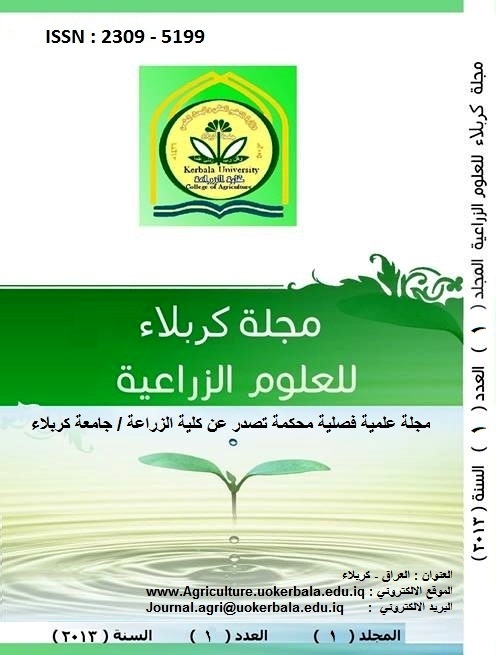Qualitative characters of cotton as affected by magnetized water and weed control with trifluralin
DOI:
https://doi.org/10.59658/jkas.v1i1.332Abstract
A field experiment was conducted at the Experimental Farm, Department of Field Crop Sciences - College of Agriculture - University of Baghdad, during summer season of 2008 and 2009 to investigate the qualitative characters of cotton as affected by magnetized water and weed control with trifluralin herbicide. A randomized complete block design arranged according to split-plot was used with three replicates. The study included four levels of magnetic water strength (0, 500, 1000 and 2000 Gauss ) as main plot treatments and five application rates of trifluralin (0, 0.6, 1.2, 2.4 and 3.6 l.ha-1), and weed free as sub plot treatments. The results showed significant effect of magnetic water on almost all characters studied. Magnetic water of 500 Gauss caused lowest dry weight of weeds in both seasons and recorded 254.8g.m-2 compared with 320.8 8g.m-2 for normal water treatment in 2008 season and 136.4 g.m-2 compared with 177.3 g.m-2 in 2009 season. Alsomagnetic water of 5oo gauss caused highest fiber length in both seasons and recorded 26.73 as compared with 26.11mm for normal water treatment in 2008 season and 26.98 as compared with 26.24 in 2009 season. Oil percentage also increased and recorded 18.70% and 20.32% compard with 17.53% and 18.91% in both seasons. Closer impact resulted between lower application rate of herbicide (1.2 l.ha-1) and highest application rate (2.4 l.ha-1) on fiber length, fiber strength, and fiber microner in 2008 and oil and protein percentage in both seasons. Also significant interaction effects was obtained between magnetic water of (500 Gauss) and application rate of trifluralin.. It was concluded that magnetic water technique could be used to improve quality characters of fiber and seed of cotton. Similarly magnetized water may increase efficiency of lower application rates of trifluralin herbicide which may lead to reduced the cost of this herbicide and the environmental pollution.
Downloads
Published
How to Cite
Issue
Section
License
Copyright (c) 2013 Copyright (c) 2024 is the Author's article. Published by the Journal of Kerbala for Agricultural Sciences under a CC BY 4.0 license

This work is licensed under a Creative Commons Attribution 4.0 International License.
Licensing Terms
All articles are published under a Creative Commons License and will be directed to the Creative Commons Attribution 4.0 International License (CC BY 4.0) That permits use, distribution, and reproduction in any medium, provided the original work is properly cited. This license also allows the work to be used for commercial purposes.
Use by both non-commercial and commercial users
This content is licensed under a Creative Commons Attribution 4.0 International (CC BY 4.0) license, permitting use by both non-commercial and commercial users. Individual users may access, download, copy, display, and redistribute the articles to colleagues, as well as adapt, translate, and text- and data-mine the content, subject to the following conditions:
- The author's moral rights, including the right of attribution and the right to protect their work from derogatory treatment, are respected.
- Where content in the article is identified as belonging to a third party, users must ensure that any reuse complies with the copyright policies of the owner of that content.
- If the article content is reused for research or educational purposes, users should maintain a link to the appropriate bibliographic citation, including the DOI and a link to the published version on the journal's website.

